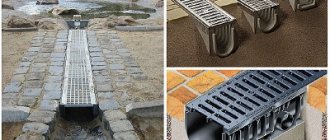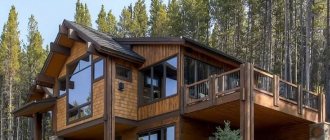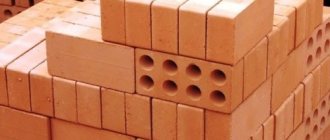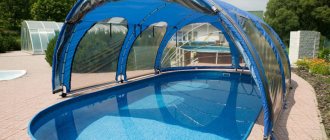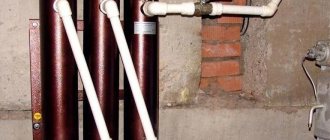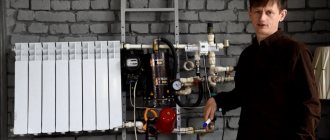Here you will learn:
- Fire wood stoves
- What are fuel briquettes made from?
- Advantages and disadvantages of fuel briquettes
- Popular types of wood briquettes
Despite the widespread construction of gas pipelines, there are still many settlements and places in Russia where there is simply no gas. People have to use alternative heat sources, for example, solid fuel boilers. These units operate on wood, but recently more modern types of fuel have begun to be produced for them - these are fuel briquettes for heating stoves. Let's look at them in more detail and find out their advantages and disadvantages.
In this review we will look at:
- Disadvantages of classic firewood;
- Fuel composition;
- Main types of briquetted fuel;
- Pros and cons of briquettes for the stove.
After reading the review, you will be able to make a choice in favor of traditional firewood or in favor of more modern briquette fuel.
Furnace firing rules
- The standard size of firewood is that logs placed in the stove are approximately 5 cm smaller than the length of the combustion chamber. If, when preparing firewood, you try to make logs of approximately the same size, you can significantly facilitate the kindling process.
- Correct laying - logs are stacked so that there are gaps between them for the free passage of air.
- Wood humidity – the stove can be heated with raw wood, but this produces a large amount of tar and smoke. Therefore, as a general recommendation, there is a rule: you should heat with dry fuel, with a humidity of 20-25%.
How to properly light a wood stove
- Preparation - we clean out all the accumulated ash from the ash chamber. The remaining coals are removed and the grate is cleaned. Afterwards the presence of traction is checked. The test is done using lit paper or a candle. The flame should be drawn into the firebox.
- Laying the first layer of fuel - the so-called seed is made. Two dry logs are placed at a distance of 15 cm. A sheet of paper, previously crumpled, is placed between them, and a pile of wood chips, shavings and sawdust is poured onto it. Two more logs are placed on top, laid diagonally.
- Ignition - the seed is ignited with a splinter or a lighter. It is strictly forbidden to use flammable liquids for kindling, but the use of dry fuel is allowed (if you need to light wet wood). Ignition is carried out with the ash pan open until a buzzing sound appears, indicating that the flame has flared up. We close the damper, but not completely.
- Additional loading of fuel - 10-15 minutes after igniting the seed, you will need to add an additional portion of logs. The correct way to stack firewood is to use a poker to level out the remaining seed. After this, firewood is placed on the burning coals to the extent of ⅔ of the total volume of the firebox. The firewood is laid so that there is a gap between them. A new portion is added after burning, every 1.5-2 hours, until the temperature rises to the required level.
How to light a stove with raw wood
- Firewood is chopped into small pieces.
- The seed is made from small wood chips.
- Gradually, larger fractions of wood begin to be added.
- Once the coals have appeared, you can add regular logs.
It is better not to use damp birch firewood. When kindling, smoke and tar are released, which leads to rapid failure of the stove and smoke removal system.
How to properly heat a brick oven in winter
The combustion temperature of wood in the stove is at least 300°C. Dry fuel burns, heating the flue gases to 400-450°C. The temperature difference between frozen brick and burning wood leads to cracking of the masonry and seams. As a result, after a season of operation, a major overhaul of the brick kiln will be required.
How to light a stove correctly so as not to get burned
- It is forbidden to completely close the dampers and the vent in order to increase the burning time of the wood.
- Before kindling, check for draft.
- The firebox is heated gradually; as the chimney heats up, the draft increases.
- Regular maintenance is carried out - if necessary, the chimney is cleaned, faults are eliminated.
- We use high-quality dry wood.
Particular care should be taken when using coal. During combustion, coal rock requires more oxygen than wood. After the air burns out in the firebox, the draft will worsen and carbon monoxide will enter the room.
When can you light the stove after laying?
It is important to avoid dampness in the firebox and smoke ducts; to do this, open all doors and windows, and only then light the fire. The work is carried out at least 2-3 days after the completion of masonry work. The combustion is carried out for 0.5-1 hour not at full power. Heat the stove 2 times a day. Finely chopped firewood, wood chips, and shavings are used as fuel.
You cannot burn with full logs. The forced drying process lasts 4-6 days
Heat the stove 2 times a day. Finely chopped firewood, wood chips, and shavings are used as fuel. You cannot burn with full logs. The forced drying process lasts 4-6 days.
Varieties
Fuel briquettes differ in the material that is the main one in their production and the technology underlying their production.
The raw materials for fuel briquettes are:
- various wood of all species - shavings, sawdust, branches;
- dust and fine fraction of hard and brown coals;
- agro-industrial waste - straw, sunflower husks, buckwheat, rice;
- peat.
Let's consider the main technical characteristics of fuel briquettes made from various raw materials.
| View | Heat transfer, kW/kg | Humidity, % | Ash content, % | Approximate price for 1 ton, c.u. |
| Wood briquettes | 5,2-5,8 | up to 12 | 1 | 102 |
| Coal briquettes | 7,55 | 10-15 | 12 | 150 |
| Brown coal briquettes | up to 5 | 10-15 | up to 30 | 70 |
| Eurofirewood made from sunflower husks | 4,5-5 | 10 | 5 | 79 |
| Straw briquettes | 4,8-5,2 | 10 | 4 | 65 |
| Peat briquettes | up to 4.5 | before 18 | 20 | 90 |
Fuel briquettes should be stored in a well-ventilated area where there is no free access to moisture. In the summer, briquettes cannot be stored on the ground without being separated by a film from below from evaporation from the soil, since moisture condenses on the packs of briquettes at night. Therefore, on the bottom of the pallet under the packs it is necessary to arrange a hermetically sealed insulation from the ground, for example, you can use plastic film.
You can read about the features of fuel briquettes from manufacturers Ruf, Pini Kay, Nestro and Nilson here.
Simple cylindrical briquettes
This is the most common type of fuel briquettes, made in the form of cylinders. Sawdust and small wood waste are used as manufacturing materials. All this is pressed under low pressure using a non-toxic adhesive base. After this process is completed, the finished briquettes are put up for sale. Such fuel is inexpensive, but cannot boast of high strength. They tolerate moisture very poorly, crumble and fall apart.
Sunflower fuel briquettes
Fuel briquettes from coal and peat
Based on the name, it becomes obvious that coal and peat are used to create such fuel briquettes. Coal and peat briquettes are used for lighting stoves and solid fuel boilers. Fuel made from coal has a high combustion temperature, but it also produces a large amount of ash.
Fuel briquettes from coal
Kindling the bath
Eurobriquettes are a universal fuel; they can be used to heat all types of stoves and boilers. They can be used in outdoor grills and home fireplaces. At the same time, the consumption of fuel briquettes is always significantly less than conventional firewood.
Many people are interested in whether it is possible to heat a stove with fuel briquettes if it is made of steel, like an ordinary heater? This question is quite logical, since such stoves have restrictions on the calorific value of the fuel; you cannot heat a steel sauna stove with black coal, which emits 4900 kcal/kg of heat. But in the case of Eurobriquettes, less heat is released, which means they can be used to heat a stove in a bathhouse.
For a bathhouse, not only the heat generated is important, but also the duration of burning of wood or alternative fuel. The longer the wood burns with maximum heat release, the better it is for the sauna stove and the sauna itself. Whole package of fuel briquettes
Whole package of fuel briquettes
Lighting fuel briquettes is not very easy, the fire does not catch immediately, but after they light up, they will burn and smolder for a couple of hours, which is much longer than the combustion of ordinary firewood. Such a long combustion time of fuel briquettes is explained by their high density and low humidity.
Let us note that, according to people’s reviews, you should not completely fill the firebox of a sauna stove with Euro-wood, so as not to quickly reach the maximum heat transfer values.
An interesting point with Eurobriquettes is the residues left after their combustion. Having increased density characteristics, this fuel burns almost completely; it does not leave a large amount of ash, only a small pile of ash. Ash from fuel blocks smells unpleasant, but is an excellent fertilizer.
When Eurobriquettes burn, virtually no smoke is emitted, which is very valuable for maintaining the cleanliness of fireboxes, boilers, and chimneys. According to experts, linden fuel briquettes contain the least amount of resin, so when using such fuel, chimneys and boiler nozzles suffer the least.
Combustion of Eurobriquettes in the furnace furnace
Fuel briquettes are an excellent option for lighting a black sauna. As we have already said, this fuel is environmentally friendly, does not emit smoke, provides enough heat, and phytoncides appear in the heated air, which have a beneficial effect on the human body and improve immunity. Using the same linden eurobriquettes, you will feel how your body is healing, inhaling the pleasant aromas of flowers, honey and trees.
Of course, there is also a drawback to this type of fuel - it cannot quickly generate a lot of heat, it releases it gradually. As we have already said, the combustion is uniform, which, unlike firewood that flares up quickly and quickly dies out, allows you to easily maintain the same temperature.
What fuel should I use in my stove?
An important factor for maintaining a constant temperature is the correct choice of long-burning stoves, which are refueled periodically and the fuel in them burns much longer. Owners of country houses or summer cottages can use artificial firewood to heat their premises, but it is convenient to use briquettes to light a fireplace. To do this, it is better to place them on paper and birch bark, which will speed up the ignition process. In the same way, you can use firewood, which does not always light well. To prevent soot from remaining as sediment in the chimney, it is recommended to throw a pinch of table salt into the fire with each addition.
General information
Fuel briquettes, or Eurofirewood as they are also called, are made from pressed natural materials, most often sawdust, sometimes peat or straw. During the pressing process, most of the moisture is removed from the wood, which makes it possible to obtain high calorific characteristics. Unlike firewood, whose maximum dryness is determined by 20% humidity, the same parameter for fuel briquettes is 8-9%.
This compact sawdust wood has a higher heating value than traditional firewood, it also lights faster and does not emit fumes or odors. Another type of natural biomass fuel is pellets in granular form. It consists of the same process as the briquette, which varies only in size, the latter being smaller, thereby achieving that they flow like grains, allowing practical and automatic dosing.
Briquette agglomeration requires the use of sticky fuel, which is mixed with charcoal, pressed to form a block or briquette, and then passed through a drying oven to settle it, evaporating the water, so that said block is sufficiently stable to be used in the same combustion equipment or cooking common charcoal.
The design of briquettes can be different:
- Eurobriquettes RUF - made exclusively by pressing without additional processing.
- Eurobriquettes Pini-Kay are compressed sawdust fired with a gas-air mixture to create a more durable shape, which increases storage time and protection from moisture.
Regardless of the type of fuel briquettes, their density is higher than wood, which allows them to burn well and release a large amount of heat. Thermal characteristics differ for Eurobriquettes made from different materials; usually high-quality types of wood, cereal seed husks, straw, and peat are used.
Recommended form of using briquettes
The virtual absence of fine material and dust, as well as its uniformity, greater durability and calorific value, make briquettes a more efficient fuel than conventional coal. If the initial fire is not sufficient, briquettes can be added without pre-ignition as they do not emit toxic gases.
- Turn the briquettes the same way you are used to turning the coal.
- Create a "bed" with briquettes, lighted and don't touch them anymore.
- This does not affect the taste of the dishes.
Before biomass can be used for energy purposes, it must be converted into a more convenient form for transportation and use.
Direct use of fuel blocks
Due to the fact that fuel briquettes are made from drier wood, their calorific value is significantly greater than that of ordinary firewood or brown coal and is remotely comparable to the characteristics of black coal. For example, dry birch firewood emits 2500 kcal/kg when burned, brown coal about 3800 kcal/kg, and fuel briquettes 4500 kcal/kg. Thus, for heating premises, the option with such fuel is quite acceptable, but are fuel briquettes suitable for a bathhouse, is it possible to heat a stove in it using this fuel.
Biomass is often converted into derivative forms such as charcoal, briquettes, gas, ethanol and electricity. Conversion technologies include simple and traditional processes such as the production of charcoal in underground fires; to highly efficient processes such as dendro-energy and cogeneration.
Direct combustion processes
Direct combustion processes. This is the oldest and most common method to date to extract energy from biomass. Direct combustion systems are used to produce heat that can be used directly, for example, for cooking or drying agricultural products. Additionally, it can be used to produce steam for industrial processes and electricity. Direct combustion technologies range from simple systems such as ovens, furnaces and boilers to more advanced systems such as fluidized bed combustion.
Popular types of wood briquettes
We have already talked about the production of fuel briquettes for heating boilers and furnaces, as well as their key advantages and disadvantages. It remains to figure out what types of briquettes are presented on the domestic market.
Fuel briquettes RUF
This fuel resembles white or wood-colored bricks in appearance (the shade varies widely). RUF briquettes are made from dry sawdust by pressing under high pressure. As a result, Euro-firewood is born, which can be used in any type of stove. Their distinctive feature is the inscription RUF, embossed on both sides.
RUF fuel briquettes for heating stoves are characterized by the release of a large amount of heat - they are almost one and a half times more profitable than firewood. They are easy to load combustion chambers and store them in stacks. Pressed bars are not afraid of moisture, but there is also no need to expose them to direct water. This fuel is supplied by many manufacturers - a typical example is. By the way, it also sells many other types of solid fuel.
Eurobriquettes PINI KAY
An interesting feature of these Eurobriquettes is their unusual shape - they resemble square pencils from which someone has taken the lead. That's why they are called "pencils". In order for it to burn with the release of a large amount of heat, a hole is made in it, increasing the draft. The “pencils” themselves look dark, as they were fired. This procedure makes them more durable and removes excess moisture.
The disadvantage of PINI KAY fuel briquettes for heating stoves is that they are more expensive than firewood and even more expensive than any other types of fuel. But they burn well, releasing a large amount of heat. They are also convenient to transport and store. Thanks to their shape, they are ideal for lighting fireplaces. Some people take them with them into the wild to use PINI KAY bars instead of wood for a fire.
Simple cylindrical briquettes
The simplest fuel briquettes for heating stoves are also on sale - in the form of cylinders. They are made from pressed sawdust and small wood waste. All this is pressed under slight pressure using a non-toxic adhesive base, after which the finished bars are sent to consumers. This fuel is cheap, but has one distinct drawback - low strength. It easily disintegrates and crumbles and does not withstand exposure to moisture.
Fuel briquettes from coal and peat
Peat and coal fuel briquettes for heating stoves are made from peat and coal, respectively. The starting materials are formed into small cylinders. The fuel can be used to light stoves and solid fuel boilers. Coal products give a high combustion temperature, but are characterized by high ash content. As for peat fuel, it is ideally suited for long-burning stoves, but it also produces a lot of ash.
Briquettes for furnaces and boilers
As an alternative to firewood, fuel briquettes have a number of advantages:
- Wood burns longer and produces more heat;
- No sparks, much less smoke;
- Very economical, because you can make briquettes with your own hands from waste, that is, there will be virtually no costs;
- There is no need to throw away the ash; it will become an excellent fertilizer for garden beds;
- When stored, identical briquettes take up less space than a traditional firewood box;
- Can be used not only for fireplaces and stoves, but also for solid fuel boilers.
In general, as experts note, the production of fuel briquettes can become a profitable business.
To produce fuel briquettes, you can use a variety of materials, and the vast majority are waste that is found in every household:
- Waste paper. Newspapers, cardboard boxes, scribbled notebooks - everything that is lying idle at home;
- Agricultural waste. For example, straw, sunflower husks, dry plant stems;
- Waste from the garden and vegetable garden. Fallen leaves are also used, as are tops of root crops, dry grass, and pulled out weeds;
- Branches, shavings, wood chips, sawdust, that is, all wood waste, including that remaining after pruning trees on the site.
Important! Some owners add plastic bags and film to the plant and wood pulp. Experts are against this approach, because in this case briquettes can no longer be called environmentally friendly fuel. And you can’t use ash as fertilizer
In general, there are no official recommendations regarding the addition of polyethylene film to briquettes; everything is at the owner’s own risk.
And you can’t use ash as fertilizer. In general, there are no official recommendations regarding the addition of polyethylene film to briquettes; everything is at the owner’s own risk.
To get started, you will need to grind the raw materials, everything except sawdust, seed husks and small shavings. For this purpose, a garden shredder is used, the choice of which we have already written about. We thoroughly chop all branches, sticks, leaves, wood chips, dry grass, and straw to obtain prepared raw materials for fuel briquettes.
Important! An ordinary garden shredder will not cope with paper and waste paper. You will have to tear it by hand, cut it, use a shredder
Clay and starch, as well as wax, are most often used as binders in the mixture for fuel briquettes. Portland cement is sometimes added, but it greatly increases the ash content of the fuel. Sugar and molasses are also an option, but they are expensive. If it is possible to find waste from pulp and paper production, you can use sulfite-yeast mash. However, it contains too much moisture.
Important! If fuel briquettes are made from sawdust and other wood waste, then binders are not needed. They are lignin, a natural polymer initially contained in wood and released at high temperature and under pressure. But this rule applies if baking is used rather than natural drying.
But this rule applies if baking is used rather than natural drying.
In addition, binders are not needed if the mixture contains paper. It is softened by water, and in itself serves as a good glue that holds all the other components of the briquette.
If clay acts as a binder, then its proportion with waste should be 1:10, no more. Water is added little by little so that the whole mixture acquires the consistency of a paste, which will be easy to shape into the desired shape.
You can use a concrete mixer or a construction mixer to mix the mixture. This will speed up the process and make the mixture smooth. Next you need a mold for pressing. Sometimes summer residents even use old pots, wooden boxes, and other items that are no longer needed in everyday life.
The easiest way is to manually press the mixture into the chosen shape and then dry it in the sun, naturally. But manual efforts may not be enough to get a high-quality, non-scattering fuel briquette. Therefore, home craftsmen usually use various mechanized presses. If you have a vibrating table, then you don’t need a press.
The process of creating a mixture for fuel briquettes and their pressing and molding is simple, but labor-intensive. That is why many people prefer to either buy ready-made briquettes or purchase special machines that significantly facilitate production. In addition, we admit that factory briquettes, which are formed under 20-ton presses, are much denser, and therefore will burn longer.
Paper raw materials
Waste paper has a high level of combustion, releasing a huge amount of ash.
One kilogram of compressed crushed material smolders for about two hours, and the formation of ash after burning barely reaches 5% of the original volume.
When creating fuel briquettes yourself, you can use waste paper. This will require a lot of material, and the manufacturing process itself is quite labor-intensive:
- Stage 1. The paper is shredded using a special combine: doing this manually or in any other way will be extremely problematic. Pieces of waste paper should not exceed the size of 20x20 mm.
- Stage 2. Cut paper and cardboard are poured with heated water and wait until the material is completely soaked.
- Stage 3. Then the remaining liquid is removed, and the mass itself is placed in prepared forms for drying under natural conditions. Here it is necessary to control the maximum degree of drying so that no excess liquid remains.
To bind paper into products, they use pine needles, hulled cereals, and straw. There are other options, but the above are the most affordable in a private garden plot.
Disadvantages of binders in the production of briquettes:
- Large needles are finely chopped by hand with simple scissors. This is hard work and requires a huge amount of time. In finished briquettes, protruding needles can scratch the skin of your hands.
- There will be even more problems with chopped plant stems, husks, and straw. Despite the ease of use as raw materials for the finished product, they cannot withstand storage in woodpiles and warehouses, since after drying they become excellent food for rodents.
Fuel briquettes not made from sawdust
In addition to sawdust, the raw materials for the manufacture of fuel cells can be seed husks, coal dust, paper, etc. If there is a large amount of available paper, then the production of Euro-firewood can be established from it. The technological process will be as follows:
- paper is cut into small pieces;
- the raw materials are soaked in warm water until it becomes a liquid porridge; you can add a little starch to the solution;
- Excess moisture is removed from the resulting mass;
- paper dough is stuffed into molds;
- After almost all the remaining moisture has evaporated, the briquettes are removed and sent for drying.
Advantages of briquettes
Fuel briquettes have a lot of advantages. Reviews from consumers and experts make it clear that in addition to being environmentally friendly, Euro firewood has a high calorific value. It is 2 times higher than that of ordinary wood. There are several explanations for this.
Wood moisture content is about 15%. When producing briquettes, the material is heavily dried. The result is a product made from the same wood, for example, but with a moisture content of 4 to 8%. It is this factor that causes the combustion temperature of the material to increase.
The second important reason why a similar effect is observed is the high density of Euro-firewood. It is 0.9-1.3 g/cm3
Ordinary wood has a density of 0.4-0.8 g/cm3. This means that the substance that undergoes combustion will be larger by the same volume. These reasons determine the high calorific value of Eurowood.
Storage conditions
Due to differences in the production process and raw materials, fuel briquettes differ in their degree of resistance to environmental influences. General conditions suitable for their storage can be described as follows:
- air temperature from +5 to +40 ºC;
- relative humidity 30–80%;
- there are no sources of open fire nearby;
- no direct sunlight;
- The fuel is protected from exposure to water and aggressive environments.
Subject to these conditions, fuel briquettes will retain their properties throughout the entire guaranteed shelf life, up to 3 years.
Important process characteristics
Raw material moisture
The production technology for any briquettes requires drying and grinding of raw materials. If this fact is neglected, then as a result the sintering and gluing reaction when exposed to temperature will be ineffective: the briquette may fall apart at the exit from the briquette.
During manufacturing, you should be able to bring the raw material to a moisture content of 8...14%.
The operation can be neglected if you have piece production (for your own needs in very small volumes). Provided that there is a room, a platform where the raw materials can be dried and stored in a dry state until the press is started.
Be aware of the weather: raw materials stored in damp sheds will be of no use. Before drying wood chips or sawdust naturally, make sure that there is no access to moist air from the street in the area designated for this purpose.
Performance
The volume of briquettes produced directly depends on access to raw materials, sales volumes and own consumption.
To determine the volume, you must at least roughly understand what part of the production will be used for your own needs, and what part will be sold.
When calculating productivity, keep in mind that most small companies carry out production before the heating season, after which there is an active surge in sales, and then stagnation sets in on the market: equipment stops, raw materials accumulate. Work resumes only in the spring.
Large companies work more rhythmically: with constant access to raw materials, they produce briquettes all year round. But they trade like everyone else - a month or two before the heating season. After which, the entire briquette produced goes to a warehouse, if there is no other market (or for export to Europe, but Europeans buy in large wholesale).
Investment volume
Making fuel briquettes with your own hands using the “roof” or “pinkey” technology is quite expensive at the first stage:
- for micro-businesses, investments are about 2...4 thousand dollars for handicraft production;
- for small and medium-sized businesses, the minimum will have to start from 10 thousand dollars for a small sawmill;
- professional lines for permanent work in this direction cost from 100...130 thousand dollars and more.
Charcoal briquetting
When producing charcoal, about a quarter of it turns out to be substandard - small pieces and dust. To turn this waste into income, you can make briquettes from them. Charcoal briquettes can also be made at home; if necessary, you can make raw materials for this (charcoal yourself). The principle of briquetting charcoal is no different from the formation of the same fuel from coal:
- Substandard coal is crushed.
- Mix with binder. In this case, a regular starch paste will do the job well. The output should be a slightly moist mass. Some of the dust rolls into small lumps.
- The resulting mixture is fed into a press, where briquettes are formed.
This video clearly shows the entire technology of charcoal briquetting, but the guys created a form specifically for the customer (church tablets made from charcoal for incense were ordered). Similarly, you can make a mold of any configuration.
Conclusions. Briquettes from coal crumbs and dust (stone and wood) can be made at home. It is difficult to achieve commercial results (only through automation, and therefore expensive equipment), but for home use it is possible to make a simple installation.
Firewood
Firewood from different types of wood will keep any room cool.
As for firewood, this is a classic option that is still in demand today. A stove heated with wood can heat the entire house, filling the room with a special atmosphere of comfort and warmth. Quite often, even firewood is used for fireplaces. After all, the natural aroma of wood can serve as a kind of air freshener. And in a modern interior, a bunch of logs will look harmonious.
Advantages
The main advantages of firewood include the following:
- environmental friendliness;
- naturalness;
- high heat transfer;
- availability;
- low cost.
We advise you to read more about the use of firewood for ignition on our website.
Firewood is a natural material of plant origin, used not only in construction, but also in the stove business. A fairly large number of wood species can be used for firewood. Moreover, each breed has its own characteristics and performance characteristics. As a rule, the following are chosen for the log house:
- oak;
- birch;
- alder;
- aspen;
- linden;
- pine or spruce.
